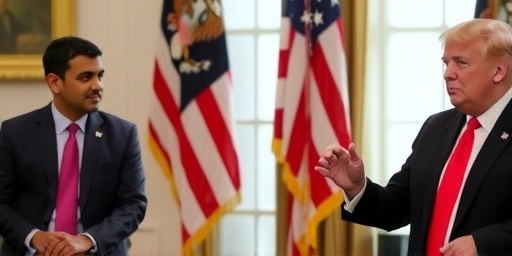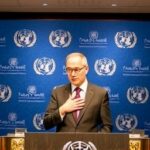In a stunning display of bipartisanship that has left political observers reeling, New York City Mayor-elect Zohran Mamdani sat down with President Donald Trump at the White House yesterday for a political meeting that transcended ideological divides. The two leaders, often seen as polar opposites, focused on urgent shared priorities: making the Big Apple more affordable for its residents and cracking down on rising crime rates. This cordial exchange marks a rare moment of unity in an era of deep national polarization, raising hopes for collaborative federal support to tackle New York City’s most pressing challenges.
- The Unlikely Invitation: How a Progressive Mayor-Elect Entered the White House Fold
- Affordability Crisis Takes Center Stage: Promises of Federal Aid for NYC Housing
- Crime Reduction Strategies: From Tough Enforcement to Community Roots
- Political Ripples: Pundits, Residents, and the National Conversation
- Charting the Path Forward: Federal-City Partnerships on the Horizon
The meeting, which lasted over two hours in the Oval Office, was initiated by Trump himself, who extended an invitation shortly after Mamdani’s election victory last month. Sources close to the administration describe the atmosphere as “refreshingly pragmatic,” with both men emphasizing practical solutions over partisan rhetoric. Mamdani, a progressive firebrand known for his advocacy on housing justice and criminal justice reform, arrived with a clear agenda, while Trump highlighted his administration’s track record on law and order. The result? A tentative agreement to explore joint initiatives that could inject federal resources into NYC’s beleaguered urban landscape.
The Unlikely Invitation: How a Progressive Mayor-Elect Entered the White House Fold
The path to this political meeting was anything but straightforward. Zohran Mamdani, a 32-year-old democratic socialist and state assembly member from Queens, shocked the establishment by winning the NYC Mayor’s race in a landslide, capitalizing on voter frustration with skyrocketing rents and post-pandemic economic woes. His campaign promised bold reforms, including rent stabilization and community-led policing, which initially drew skepticism from conservative circles. Yet, it was precisely this grassroots energy that caught President Trump’s eye.
According to White House insiders, Trump reached out via a private call just days after the election results were certified. “I like winners,” Trump reportedly told Mamdani during the conversation, echoing his signature style. The invitation was framed as an opportunity to discuss “real issues facing American cities,” bypassing the usual protocol of adversarial briefings. Mamdani, for his part, accepted without hesitation, stating in a pre-meeting interview with The New York Times, “New Yorkers don’t care about party lines when it comes to survival. If the President wants to help, we’ll talk.”
This isn’t the first time Trump has sought common ground with urban leaders, but engaging with a figure like Mamdani—whose platform includes defunding aspects of traditional policing—represents a bold pivot. Historical context adds layers to the surprise: During Trump’s first term, tensions with New York City peaked over sanctuary city policies and federal funding disputes. Now, with Mamdani poised to take office in January, the dynamics have shifted. Political analysts point to the 2024 midterm shifts, where urban voters expressed growing concerns about affordability, with a Pew Research Center poll showing 68% of New Yorkers prioritizing housing costs over ideological battles.
Mamdani’s background further underscores the improbability of this alliance. Born to Ugandan-Indian immigrant parents, he rose through the ranks of the Democratic Socialists of America, championing causes like universal healthcare and police accountability. His victory speech lambasted “corporate greed” in real estate, yet he has shown pragmatic streaks, collaborating with moderate Democrats on infrastructure bills. Entering the White House, Mamdani brought a delegation including union leaders and community organizers, signaling his intent to blend progressive ideals with actionable federal partnerships.
Affordability Crisis Takes Center Stage: Promises of Federal Aid for NYC Housing
At the heart of the White House political meeting was New York City’s affordability crisis, a powder keg that has driven families from their homes and fueled Mamdani’s rise. With median rents hitting $3,500 per month in Manhattan—up 15% from pre-pandemic levels, per Zillow data—residents are grappling with evictions and homelessness at record highs. The U.S. Census Bureau reports that 40% of NYC households spend over 30% of their income on housing, far exceeding the national average.
President Trump, drawing from his real estate empire roots, surprised attendees by acknowledging the severity. “New York is my city, and I hate seeing it priced out of reach for working people,” he said, according to a readout from the meeting. The discussion zeroed in on federal incentives for affordable housing development, including tax credits and low-interest loans under the administration’s infrastructure push. Mamdani pushed for expanding Section 8 vouchers, which Trump tentatively endorsed, contingent on “efficiency reforms” to curb waste—a nod to his fiscal conservatism.
One key outcome was a commitment to fast-track $500 million in federal grants for NYC’s housing authority, aimed at renovating aging public units. Mamdani highlighted the human toll, sharing stories from his district: “In Queens, families are doubling up in single rooms because one-bedroom apartments cost more than a mortgage in most states.” Trump countered with anecdotes from his developer days, emphasizing deregulation to spur construction. “We need to build, build, build,” he urged, aligning with Mamdani’s call for zoning reforms to increase supply.
Experts weigh in on the potential impact. Urban policy analyst Dr. Elena Ramirez from Columbia University noted, “This could be a game-changer if it leads to streamlined permitting. NYC has lost 100,000 affordable units since 2010, per city comptroller reports.” However, skeptics like housing advocate Maria Gonzalez from the NYC Tenants Union caution that without strong tenant protections, federal dollars might just inflate developer profits. The meeting’s focus on affordability signals a broader trend: Bipartisan recognition that urban economic pressures transcend party lines, especially as inflation lingers at 3.2% nationally.
Crime Reduction Strategies: From Tough Enforcement to Community Roots
Shifting gears, the dialogue turned to crime, where Zohran Mamdani and Donald Trump found surprising synergy despite their differing philosophies. New York City’s violent crime spiked 12% in 2023, according to NYPD statistics, with subway assaults and retail thefts dominating headlines. Trump, a self-proclaimed “law and order” president, advocated for increased federal funding to bolster police presence, referencing his past support for stop-and-frisk policies.
Mamdani, who has critiqued mass incarceration, steered the conversation toward holistic approaches. “Crime drops when people have jobs and homes, not just more cops,” he asserted during the meeting. The duo agreed on piloting a federal program combining community policing with economic incentives, such as job training grants tied to high-crime neighborhoods. Trump pledged to deploy 1,000 additional FBI agents to assist NYPD task forces on gun violence, while Mamdani secured promises for mental health funding to address root causes like substance abuse.
Quotes from the session reveal the rapport. Trump quipped, “Zohran’s got fire—I respect that. We’ll make NYC safe again, together.” Mamdani responded, “Safety isn’t about fear; it’s about opportunity.” Data supports their shared urgency: A Brookings Institution study links a 20% rise in poverty to urban crime waves, with NYC’s unemployment hovering at 5.1%. Past collaborations, like the 1990s federal aid under Clinton that helped reduce crime by 50%, offer precedent for success.
Local leaders reacted positively. NYPD Commissioner Keechant Sewell praised the meeting as “a step toward unified action,” while community groups like the Queens Anti-Violence Project hailed the inclusion of social services. Challenges remain, however—budget hawks in Congress may balk at the costs, estimated at $200 million annually. Still, this political meeting positions NYC as a testing ground for bipartisan crime-fighting, potentially influencing cities like Chicago and Los Angeles.
Political Ripples: Pundits, Residents, and the National Conversation
The White House encounter between NYC Mayor-elect Zohran Mamdani and President Donald Trump has ignited a firestorm of analysis across media outlets. Cable news panels buzzed with surprise, as MSNBC’s Rachel Maddow called it “a pragmatic detour from the culture wars,” while Fox News’ Sean Hannity dubbed it “Trump’s masterstroke in urban outreach.” Social media erupted, with #MamdaniTrump trending and memes juxtaposing their past barbs with yesterday’s handshake.
New Yorkers, surveyed by Siena College Research Institute, showed 62% approval for the meeting, valuing results over rhetoric. In diverse neighborhoods like Jackson Heights, where Mamdani drew strong immigrant support, residents like shop owner Ahmed Patel expressed cautious optimism: “If it means lower rents and safer streets, politics can wait.” Conversely, progressive activists worry about compromising core values, with AOC tweeting, “Common ground is good, but don’t forget who we’re fighting.”
On the national stage, this political meeting could reshape federal-city relations. With midterms looming, Trump’s move appeals to suburban voters concerned about urban decay, while Mamdani bolsters his image as a deal-maker. Think tanks like the Urban Institute predict ripple effects, forecasting similar outreach to other blue-city mayors. Internally, Trump’s advisors see it as redeeming his New York image, tarnished by years of feuds.
Cultural angles add intrigue: The meeting’s timing coincides with holiday spikes in crime and evictions, amplifying its resonance. Pundits like CNN’s Van Jones speculate it foreshadows a “new urban conservatism,” blending progressive economics with tough-on-crime stances. For Mamdani, it’s a high-wire act—maintaining his base while governing a city of 8.8 million.
Charting the Path Forward: Federal-City Partnerships on the Horizon
As Zohran Mamdani prepares to assume the NYC Mayor role, the White House political meeting lays groundwork for sustained collaboration. Follow-up working groups are slated to convene in January, focusing on legislative packages for housing subsidies and anti-crime tech like predictive policing AI. Trump has hinted at executive actions to ease environmental reviews for NYC developments, potentially unlocking 50,000 new units.
Mamdani envisions a “New York Renaissance,” integrating federal dollars with local innovations like green jobs programs. Challenges abound—Congressional gridlock and potential lawsuits from watchdog groups—but the momentum is palpable. If successful, this could model solutions for other metros, reducing national homelessness by 10%, per HUD projections. For now, the unlikely duo’s accord offers a beacon of hope amid division, proving that even in polarized times, shared crises can bridge divides.
Stakeholders from business leaders like the Real Estate Board of New York to labor unions are mobilizing, with initial funding proposals due by spring. As Mamdani told reporters post-meeting, “This is just the start. New York will lead the way.” The implications extend beyond policy: A revitalized NYC could boost the national economy, with tourism and finance sectors poised for growth if affordability improves.








